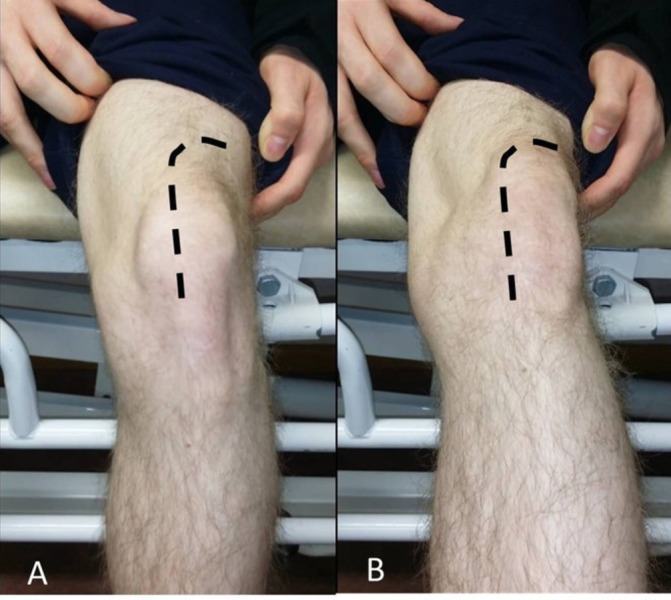Description
A 42-year-old man presented with numerous left patella dislocations. While the initial dislocation was traumatic, recent episodes were atraumatic. He had no clinical evidence of hyperlaxity, but presented with patellar apprehension and a positive J-sign. His examination was otherwise unremarkable. An MRI of his knee revealed early patellofemoral degenerative changes and tibial tubercle-trochlear groove distance of 25 mm (normal <15 mm). The patient went on to have a Fulkerson tibial tubercle transfer to improve patellar alignment.
The J-sign refers to the inverted ‘J’ track the patella takes from extension to early flexion (or vice versa) in a maltracking patella. The laterally subluxated patella suddenly shifts medially as it engages the trochlear groove of the distal femur (figure 1, video 1). The J-sign on clinical examination is suggestive of patellar maltracking and potential instability.1 2
Figure 1.

Clinical photograph showing the knee in flexion (A) and in extension (B). The dotted line delineates the inverted ‘J’ path the patella takes.
Video 1.
Demonstration of the J-sign on a left knee with known instability. In full extension, the patella is laterally subluxated and suddenly shifts medially.
Learning points.
The J-sign refers to the inverted ‘J’ track the patella takes from extension to early flexion.
The J-sign is a clinical finding indicative of patellar maltracking.
Footnotes
Contributors: OH and PE performed the literature review; PE provided the image and video; OH and ML revised the manuscript; NH supervised the writing of the manuscript and treated the patient.
Competing interests: None declared.
Patient consent: Obtained.
Provenance and peer review: Not commissioned; externally peer reviewed.
References
- 1.Sheehan FT, Derasari A, Fine KM, et al. . Q-angle and J-sign: indicative of maltracking subgroups in patellofemoral pain. Clin Orthop Relat Res 2010;468:266–75. doi:10.1007/s11999-009-0880-0 [DOI] [PMC free article] [PubMed] [Google Scholar]
- 2.Buchanan G, Torres L, Czarkowski B, et al. . CURRENT CONCEPTS IN THE TREATMENT OF GROSS PATELLOFEMORAL INSTABILITY. Int J Sports Phys Ther 2016;11:867–76. [PMC free article] [PubMed] [Google Scholar]


